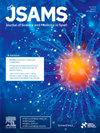流行病学和相关伤害危险因素在花样滑冰:一个系统的回顾。
IF 3
2区 医学
Q1 SPORT SCIENCES
引用次数: 0
摘要
目的:识别和批判性地评估在花样滑冰损伤流行病学和危险因素的现有证据。设计:系统回顾。方法:检索自成立至2023年11月1日的8个电子数据库。如果研究报告了花样滑冰的伤害流行病学和/或伤害风险因素,则纳入研究。非英文出版物被排除在外。使用QUIPS工具(预后因素研究质量)评估纳入研究的偏倚风险。结果:本系统综述确定了29项研究(n = 4202名花样滑冰运动员),损伤发生率为2.1 %-34 %。在一项研究中,每1000个总训练小时的受伤发生率为1.37例(n = 8)。从个体研究中确定了三个显著的内在风险因素(年龄较大、既往应力性骨折史和较高的体重)和八个显著的外在风险因素(每周训练超过12次、不吃饭、RED-s指标、腿筋和股四头肌不活动、训练而不是比赛、冰上时间增加和靴脚长度差异)。年龄作为研究最多的危险因素,由于研究设计的限制,需要仔细解释。局限性:现有数据缺乏证据质量,目前报道的花样滑冰损伤风险因素应谨慎解释。结论:关于花样滑冰损伤及损伤危险因素的高质量研究较少。由于损伤定义和数据收集方法的不同,目前可获得的文献中对损伤数据的报道不一致,这使得比较和得出结论变得困难。迫切需要标准化的研究方法来准确地确定这项运动中受伤的真正负担。本文章由计算机程序翻译,如有差异,请以英文原文为准。
Epidemiology and associated injury risk factors in figure skating: A systematic review
Objectives
To identify and critically appraise the available evidence on injury epidemiology and risk factors in figure skating.
Design
Systematic review.
Methods
Eight electronic databases were searched from inception to 01 November 2023. Studies were included if they reported injury epidemiology and/or injury risk factors in figure skating. Non-English publications were excluded. Risk of Bias of included studies was assessed using the QUIPS tool (quality in prognostic factor studies).
Results
This systematic review identified twenty-nine studies (n = 4202 figure skaters), with an injury prevalence of 2.1 %–34 %. An injury incidence of 1.37 injuries/1000 total training hours was reported in one study (n = 8). Three significant intrinsic risk factors (older age, previous history of stress fracture and a higher body mass) and eight significant extrinsic risk factors (training more than 12 sessions per week, skipping meals, RED-s indicators, hamstring and quadriceps immobility, training rather than competing, increased time on-ice time and boot-foot length difference) were identified from individual studies. Age, as the most studied risk factor, requires careful interpretation due to study design limitations.
Limitations
Existing data lacks quality of evidence and current reported injury risk factors in figure skating should be interpreted with caution.
Conclusions
High-quality research of injuries and injury risk factors in figure skating is scarce. The inconsistent reporting of injury data across the currently available literature due to variations in injury definition and data collection methods makes it difficult to compare and draw conclusions. A critical need exists for standardized research approaches to accurately determine the true burden of injury in this sport.
求助全文
通过发布文献求助,成功后即可免费获取论文全文。
去求助
来源期刊
CiteScore
7.40
自引率
10.00%
发文量
198
审稿时长
48 days
期刊介绍:
The Journal of Science and Medicine in Sport is the official journal of Sports Medicine Australia (SMA) and is an an international refereed research publication covering all aspects of sport science and medicine.
The Journal considers for publication Original research and Review papers in the sub-disciplines relating generally to the broad sports medicine and sports science fields: sports medicine, sports injury (including injury epidemiology and injury prevention), physiotherapy, podiatry, physical activity and health, sports science, biomechanics, exercise physiology, motor control and learning, sport and exercise psychology, sports nutrition, public health (as relevant to sport and exercise), and rehabilitation and injury management. Manuscripts with an interdisciplinary perspective with specific applications to sport and exercise and its interaction with health will also be considered.

 求助内容:
求助内容: 应助结果提醒方式:
应助结果提醒方式:


